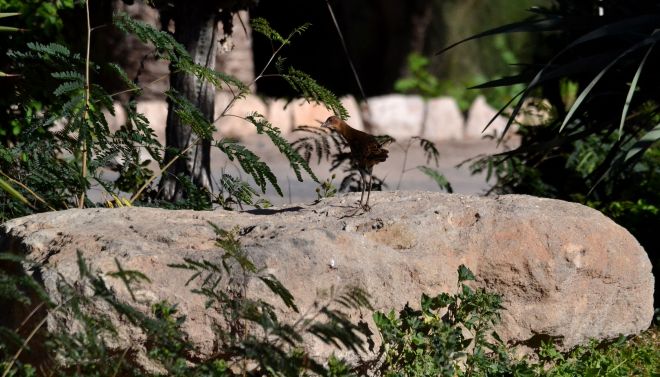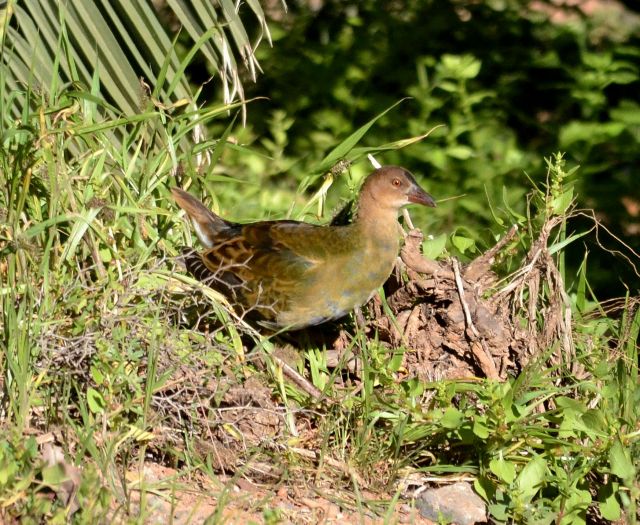It was just a short, four-night mid-winter break for me this year with the aim of seeing whether re-visiting the locations of past wildlife adventures can still be motivating. The answer appears to be yes provided there is something new and different in the mix. The Canaries desert island of Fuerteventura is also very affordable in it’s low tourist season, as myself and other Oxon birders discovered on visiting at the time the now resident Dwarf Bittern first arrived 13 months ago. Since my week in Crete last October I have received regular mail-shots from lastminute.com and so am now aware of some good and agreeably priced packages that cater for solo travellers.
For my base this time I chose Costa Calma on the peninsula at Fvta’s far south west, as I had not reached that part of the island before and some good birds turn up there. After making the booking things became interesting when another Westpal rarity from sub-Saharan Africa, a juvenile Allen’s Gallinule turned up at Caleta de Fuste on the east coast. That bird, the island’s third remained from 13th to 24th December, then the plot took another twist. Just before my departure this week what was believed to be a second Allen’s was discovered in Costa Calma itself by birders no doubt searching for the Canaries’ ninth Red-breasted Flycatcher. This bijou tripette was by now seeming seriously meant.
The Allen’s Gallinule (pictured above), a first winter had been frequenting a long and narrow forested strip that runs through the resort’s centre, at a spot between El Palmeral shopping centre and a communications mast opposite the Costa Calma Palace hotel. I arrived here at 11am on Wednesday (9th) armed with GPS co-ordinates provided by Dr Eduardo Garcia del Rey, president of the Sociedad Ornitologica Canaria who administers Canary Islands RBA on Facebook. And as soon as I walked in the bird flew up from one side of the path, a pattern that was to repeat itself over the next three hours.
Some other reports I had read suggested this lifer was approachable but that was not my experience. It was an easy bird to see but not to observe well. Whenever it caught sight of either myself or other people, the Allen’s would fly up into the tree cover overhead and that was what surprised me most. I have never thought of Gallinules or any other Rail or Crake as tree dwellers, but this one seemed totally at home up there (pictured below).
Stalking this bird while trying for acceptable pictures, I adopted a routine of sitting on an earth mound at the heart of it’s patch then walking a circuit at intervals. Occasionally I was joined by other birders there. Several more times the AG went up from close by always seeing me before I noticed it. From my impromptu base I also paid some attention to the small passerines that were active in the tree cover, as well as some rather more noisy and colourful characters.
The last-named were Red-vented Bulbul, (below, left) a native of the Indian sub-continent and parts of south-east Asia that has been introduced to many other countries. I knew there must be a reason for not coming across it in my pre-trip researches, and now learn this bird is regarded as one of the world’s most problematic invasive alien species. But it was still my second lifer of the morning and interesting to see here.
At one point the Red-breasted Flycatcher (above, right), also a first winter popped out and posed nicely, and I also noticed it from time to time darting about a very concentrated area in that species’ restless manner. But I did not find a Yellow-browed Warbler that had also been reported from this hot spot, seeing only Chiffchaffs and Spanish Sparrows besides the RBF. At one point I saw a Monarch butterfly, a resident species in the Canaries, but it did not settle.
At 14:00 pm I took a break, returning after an hour and in the late afternoon the Allen’s Gallinule became rather more confiding. A sequence of events next unfolded that turned my sojourn here into a very satisfying experience. First I spotted the bird right out in the open beside then atop a large mound (pictured below). And thereafter I was able to follow at a discreet distance wherever it went without it seeming concerned by my presence.

Just look at those legs … it should have been a supermodel
The Gallinule next began feeding in some longish ground cover and so I realised how I had put it up inadvertently a number of times earlier. This bird liked to keep in semi concealment in that habitat, but still seemed to allow a closer approach now than had been the case in the morning. I was all this time gaining a better understanding of its movements and habits and the end game was coming into sight.
When my quest relocated again to the spot that features at the top of this post I at last obtained pictures (below) to compare with all the others seen online. It had been a real privilege to spend five hours in this superb bird’s company and to gain such a variety of other images in the process.

Oh you beauty! This first winter is just beginning to acquire it’s blue adult colouring (per E G del R)
On Thursday evening (10th) I received a message from Eduardo asking if there was any further news on this rarity. I took that to mean the AG had not been reported again whilst I had been otherwise engaged with the Dwarf Bittern. So on Friday (11th) I returned to check out the same place from 15:45 to 17:20 pm, but without encountering the former again.
Instead, from my earth mound I followed the hyperactive antics of the Red-breasted Flycatcher (pictured below) through that entire interval. This tiny sprite was in exactly the same spot as two days previously, dashing about constantly, feeding in low trees and on the ground, and sitting up on a number of favoured perches. This trip’s individual was only my second record of what is a widespread central and eastern European breeder.
I wondered if I had observed the Allen’s Gallinule so well on its last day in Costa Calma, and even feared I might have spooked it, but there had been a sighting earlier on 11th and another again on Saturday (12th). Something different had indeed gone into the mix for this retro trip and my first day in Costa Calma had been a resounding success.
Note: On 18th January the Caleta de Fuste Allen’s Gallinule was re-found in it’s pre-Christmas location, confirming there were indeed two first-winter individuals on Fuerteventura through the period under discussion.












